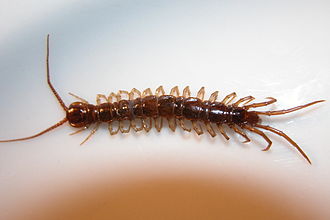Centipede

Centipedes (from the New Latin prefix centi-, “hundred”, and the Latin word pes, pedis, “foot”) are predatory arthropods belonging to the class Chilopoda (Ancient Greek χεῖλος, kheilos, lip, and New Latin suffix -poda, “foot”, describing the forcipules) of the subphylum Myriapoda, an arthropod group which also includes millipedes and other multi-legged creatures. Centipedes are elongated metameric creatures with one pair of legs per body segment. Most centipedes are generally venomous and can inflict painful bites, injecting their venom through pincer-like appendages known as forcipules. Despite the name, centipedes can have a varying number of legs, ranging from 30 to 354. Centipedes always have an odd number of pairs of legs.[1][2][3] Therefore, no centipede has exactly 100 legs. Like spiders and scorpions, centipedes are predominantly carnivorous.[4]:168
Their size can range from a few millimetres in the smaller lithobiomorphs and geophilomorphs to about 30 cm (12 in) in the largest scolopendromorphs. Centipedes can be found in a wide variety of environments. They normally have a drab coloration combining shades of brown and red. Cavernicolous (cave-dwelling) and subterranean species may lack pigmentation, while many tropical scolopendromorphs have bright aposematic colors.
Worldwide, an estimated 8,000 species of centipedes are thought to exist,[5] of which 3,000 have been described. Centipedes have a wide geographical range, even reaching beyond the Arctic Circle.[4] They are found in an array of terrestrial habitats from tropical rainforests to deserts. Within these habitats, centipedes require a moist microhabitat because they lack the waxy cuticle of insects and arachnids, therefore causing them to rapidly lose water.[6] Accordingly, they are found in soil and leaf litter, under stones and dead wood, and inside logs. Centipedes are among the largest terrestrial invertebrate predators, and often contribute significantly to the invertebrate predatory biomass in terrestrial ecosystems.
Centipedes have a rounded or flattened head, bearing a pair of antennae at the forward margin. They have a pair of elongated mandibles, and two pairs of maxillae. The first pair of maxillae form the lower lip, and bear short palps. The first pair of limbs stretch forward from the body to cover the remainder of the mouth. These limbs, or maxillipeds, end in sharp claws and include venom glands that help the animal to kill or paralyze its prey.[6]
Many species of centipedes lack eyes, but some possess a variable number of ocelli, which are sometimes clustered together to form true compound eyes. However, these eyes are only capable of discerning light and dark, and have no true vision. In some species, the first pair of legs at the head end of the centipede acts as sense organs similar to antennae, but unlike the antennae of most other animals, theirs point backwards. Unusual sense organs found in some groups are the organs of Tömösváry. These are located at the base of the antennae, and consist of a disc-like structure with a central pore surrounded by sensory cells. They are probably used for sensing vibrations, and may even provide a sense of hearing.[6]
Forcipules are a unique feature found only in centipedes and in no other arthropods. The forcipules are modifications of the first pair of legs (the maxillipeds), forming a pincer-like appendage always found just behind the head.[7] Forcipules are not true mouthparts, although they are used in the capture of prey items, injecting venom and holding onto captured prey. Venom glands run through a tube almost to the tip of each forcipule.[7]
